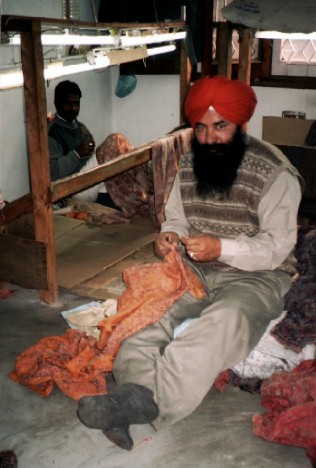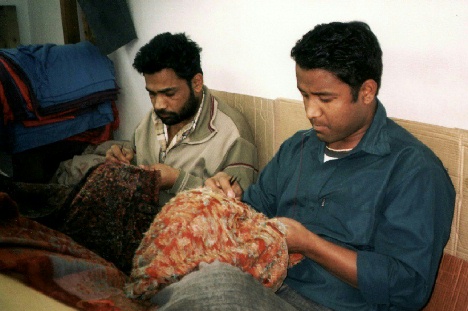Large Jamavar Shawl
Kani Gold
From Heritage Trading Company
|
|
|
 |
|
|
|
|
|
|
|
|
|
|
|
|
|
 |
|
|
Close-Up Showing Both Front Side & Hand-Cut Reverse
Side Of Shawl
|
|
|
|
|

|
|
 |
|
About Kani Shawls
As late as the 19th century, jamavar shawls from India were hand woven using a twill tapestry weave with interlocking weft threads. The bobbins holding these threads were called kanis, and the shawls themselves were sometimes known as kani shawls. The hand weaving of that type of intricately designed, jamavar shawl is no longer commercially viable, since one shawl would take a craftsman months, or even years, to complete. (Even with favorable international currency exchange rates, such pieces would cost thousands of dollars.) Jamavar shawls today are made on automated, jacquard looms.
Nevertheless, today’s shawl makers are developing techniques to more closely replicate the intricate, crisply defined motifs of the original kani jamavar shawls. One of the newest of these techniques has produced what have, somewhat confusingly, come to be known—and marketed—as kani shawls.
These modern kani jamavar shawls are woven on automated jacquard looms but are significantly different from the better known jacquard jamavar shawls. In general, the kani shawls’ motifs are more crisply defined, and a kani shawl will usually incorporate a larger number of colors than a jacquard jamavar. In order to do this, the weft threads on a kani shawl are carried along as floats on the back side of the shawl and are only woven in when their colors are required. When the weaving is finished, the float threads are cut away by hand. This hand cutting is a time consuming process and accounts for a substantial portion of a shawl’s cost.
 |
 |
| Shawl Makers Cutting the Floats from Kani Shawls | |
Because of the way they are woven, kani shawls are not reversible.
Kani shawls vary in price, depending on the number of colors used and the detailing of their motifs. Shawls with the most dense, intricate, and crisply defined motifs are more costly. The shawls we sell are described as Kani Diamond (the most expensive), Kani Gold, and Kani Silver (the least costly). All of our kani shawls are made of 100% new, Merino wool.
For more information about India shawls, please see the Definitions and Comments at the end of our listing.
|
A large, kani jamawar shawl from India. The intricate, woven, pattern is inspired by designs that date back to the Mughal Empire. |
|
| Principal Colors: | Black, Ivory, Burgundy, Turquoise |
| Fabric: | Wool |
| Kani Quality: | Gold |
| Approximate Size: | 82 Inches Long By 42 Inches Wide |
| Approximate Size: | 205 Centimeters Long By 105 Centimeters Wide |
|
This shawl is brand new, not "vintage." In other words, it's not used, damaged, or dirty. |
|
Please see all of our listings for shawls and more affordable luxuries from Jodhpur, Jaipur, and other parts of Rajasthan and India.
This item is shipped from India. Please allow 2 weeks for delivery.
D12-KL-6009
Outstanding Quality
Please see our feedback for comments like these on our jamavar shawls:
Jan-26-05 Praise : MUSEUM QUALITY (AS IN EXHIBIT, NOT GIFT SHOP) - I'M A REPEAT BUYER
Nov-2-06 Praise : Every time I open your packages, I exclaim, "Oh WOW!" Every item is stunning!
Oct-18-07 Praise : BEST PASHMINA JAMAVAR ON NET!!! I LOVE THIS COMPANY, CUSTOMER FOR LIFE!!!!!!!
May-05-09 Praise : Tout est parfait avec envoi express : merci
Dec-03-09 Praise : Best eBay experience to date, great seller. Guaranteed repeat customer here.
Jan-05-10 Praise : Wunderschöner Schal, spannendes Muster, tolle Qualität. Gerne mal wieder
Aug-28-10 Praise : Another treasure, just delighted, perfect gift for the discerning! cheers
Dec-17-10 Praise : Amazingly beautiful shawl very reasonably priced. A+A+A+A+A+
Jan-15-11 Praise : What a beautiful shawl! I gave it as a gift and my friend loved it! Excellent!
Mar-08-11 Praise : Perfect, Absolutely Gorgeous and Divine! Will buy again, Thanks
May-14-11 Praise : Love these shawls! Fast shipping! And I can shop in New York! Thank you+++
Dec-21-11 Praise : Stunning, so pleased! You won't be disappointed shopping here!
Dec-29-11 Praise : Lovely shawl, will wear it for ages! And friendly patient service! Thank you.
Jan-13-12 Praise : Excellent Ebay seller for jamawars. Best on NET!!*****
Mar-07-12
Praise : Truly
stunning and exquisiteness at its best :))
Mar-26-12
Praise : Every
one I get is so beautiful. I just love your work. Exactly as pictured
Apr-04-12
Praise : Fabulous
/Happy Buyer/Five Star Seller*****
| International Buyers - Please Note |
| Import duties, taxes, and charges are not included in the item price or shipping cost. These charges are the buyer's responsibility. |
| Please check with your country's customs office to determine what these additional costs will be prior to bidding or buying. |
| Customs activity may delay the arrival of your package. In our experience, this is infrequent, but it does sometimes happen. Thanks for your patience. |
POUR NOS AMIS QUI PARLENT FRANÇAIS (For our French-speaking friends): Châle ou écharpe en laine. Nouveau. Fabriqué en Inde. (Méthodes de paiement: Nous acceptons les cartes de crédit sur Paypal et les chèques personnels en U.S. dollars.)
|
Made of sari fabric. It's easy, beautiful, and reusable. For any Heritage Trading shawl. |
|
 |
 |
|
Only $3.99 |
|
| Click here for details. | |
Truth In Advertising: Some Definitions & Some Comments About India Shawls
FIRST, THE DEFINITIONS
Jamavar Shawls
(Also spelled jamawar, jamavaar, jhamevar)
The jamavar technique of weaving intricate, Persian-inspired motifs was brought to the Kashmir region of India in the 15th Century under the patronage of one of the kingdom's most admired rulers, Zain-ul-Abdin. Patterns in these early jamavars were created by using weft threads of various colors that did not run the full width of the fabric. Rather, they were woven back and forth in small areas to create the desired, tiny color blocks. These jamavars became fashionable with European aristocracy in the 18th Century. Because of the costly weaving technique, the patterns often covered just the edges and ends of the shawls. Even so, only the wealthiest people could afford them. The invention of the jacquard loom in the 19th Century meant that shawls with the traditional jamavar designs could be produced cost-effectively for a much larger market. And the motifs began to cover larger portions of the shawls.
|
|
|
|
Madame Riviere, 1805, By Ingre |
Countess Daru, 1810, By David |
|
Early 19th Century Portraits Of European Ladies Wearing Jamavar Shawls |
|
Today the term “jamavar” usually refers to shawls with intricately woven, Persian/Mughal-inspired patterns. (It rarely refers to the original weaving technique.) Some modern jamavars simulate earlier weaving traditions by using supplemental warp and/or weft threads, which extend across only a portion of the fabric, to create complex, multicolored designs on some areas of the shawl, while leaving large, solid color blocks in other areas.
Pashm*na (In accordance with Ebay rules, we can't spell out this word, lest our auction appear in a search for articles made of that material. But we think you'll figure out our message anyway.)
NOT a generic term for any shawl from India, “p*shmina” refers to a very specific and very costly material. "Pashm*na" is the inner coat wool of a particular Himalayan goat (Capra hircus). Articles made from "p*shmina" are very expensive, even when purchased in India directly from a manufacturer’s agent. Less expensive are blends of "p*shmina" with other materials such as wool or rayon.
In our experience, it is not possible to make a wholesale purchase of 80 inch by 28 inch, jamavar, 70% "p*shmina" blend shawls from a manufacturer’s agent in India for less than $50 (US currency) apiece. It is also not possible to circumvent the agents and buy directly from the manufacturers—we tried.
C*shmere
Also NOT a generic name for shawls from India, “c*shmere” is another name for "p*shmina". Some people prefer to use the term “cashm*re” to refer to the larger diameter fibers (15-19 microns) and reserve the term “pashm*na” for the finer grade (11-14 microns).
Kashmir
A region of Northwest India. Not "c*shmere" fabric.
Kashmiri
The adjective meaning that something is “of Kashmir.” It can mean any shawl from Kashmir or designed in the tradition of Kashmir. It does not mean "c*shmere" material. The term is often used to refer to certain types of embroidery. In one popular type of Kashmiri hand-embroidery, the pattern is made from many tiny, straight stitches. Chain stitch is another traditional style. (Heritage Trading sells some shawls with Kashmiri embroidery.) Because of Kashmir’s current political instability, much Kashmiri embroidery is now done outside that state.
Viscose
Rayon. Viscose is the word much of the world uses to refer to what Americans call rayon. Read the fine print on shawl auctions. Some shawls described as "pashm*na" in the title are revealed to be 100% viscose in the small-font part of the description.
THE COMMENTS: TRUTH IN ADVERTISING
India does not have the strict truth-in-advertising laws that are found in the United States and elsewhere. Consequently, some Indian manufacturers will label their shawls as "p*shmina" or "c*shmere," even though they are, in reality, sheep’s wool or even synthetic. In fact, we told our Indian supplier to remove the labels sewn into a recent shipment of woolen shawls, inaccurately describing them as "pashm*na".
At Heritage Trading, we try to be clear and accurate in our ebay descriptions. We do not, at present, sell "p*shmina" or "cashm*re" shawls. We DO sell beautiful shawls with jamavar (i.e., intricately woven patterns) made of sheep’s wool. We also sell some wool-like, synthetic shawls, which are clearly described as synthetic in our listings. And we sell some blended fabrics, which are also fully described.
We encourage similar clarity and accuracy from all sellers.
Thanks for reading this. We wanted you to know.









